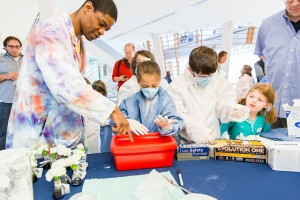So You Want To Do Science Outreach: Getting Started
The following series is based off The Rockefeller University Science Outreach Program’s presentation at the annual AAAS meeting, presented in San Jose, CA by Jeanne Garbarino, Elizabeth Waters, and Ali Cohen. The goals for this presentation and blog post series are to introduce science outreach, how to get started in science outreach, and how to leverage science outreach for professional development.

Science Outreach can be accomplished at varying degrees of involvement or commitment. Whether you are more interested in one-off, plug-and-play type of experiences that suit a demanding work schedule, or are interested in a more regular commitment, science outreach experience adds value to your professional portfolio. The entry points for getting involved are probably more obvious than you think! Here is how you can find something that works for your schedule and goals:
Figure Out What You Want to Get Out of It
It is quite obvious that science outreach often benefits the recipients of the outreach effort. However, getting involved in science outreach does not have to be entirely altruistic. Because the concept of “science outreach” is incredibly broad, it is possible to construct a narrative of science outreach experience that can advance you as you move along your career trajectory.
For example, if you are interested in going into teaching or some form of education, it is probably a good idea to find experiences in a classroom or lecture hall setting, or to develop and/or adapt science curricula. However, if you are more interested in gaining communication skills for a job outside of education, you might try science blogging, social media engagement, podcasting, or some type of public speaking centered on science. You can also harness science outreach activities to grow program management and project leadership skills – liaising between groups or taking on some type of official responsibility for science outreach efforts does count as professional experience.
Science outreach can also serve those who are interested or already have a career in academic research. With the funding climate as tight as it is, having a plan for engagement outside of research can raise the competitiveness of a grant application. This is particularly true for the National Science Foundation (NSF), who requires the inclusion of a “broader impacts” statement for all proposals.
Assess how science outreach engagement can add value to your career development, and don’t be afraid to get creative!
You Do Have Availability, But Also Be Realistic!
There are many who feel they are under intense pressure in the laboratory or field, and don’t think they can afford to participate in activities that do not directly result in data generation. However, in this current job market, I (and many others) make the argument that scientists and engineers can’t afford not to get involved.
These days, becoming a STEM professional means so much more than only lab or field- work. Figuring out how to fit in outreach activities can be a means to hone your time management skills, at the very least. Getting involved also offers the opportunity to expand your resume or CV, and to market yourself as a well-rounded and/or service-oriented individual. However, it won’t work to your advantage if you over committed. Be sure to make the time, but also be smart about how much time you can actually offer. When looking for science outreach opportunities, don’t forget to get a detailed explanation of expectations and work involved.
Don’t Reinvent the Wheel: Look for established activities
As mentioned above, science outreach involvement does not have to be a major time suck. Many times, there are a variety of initiatives already taking place, either formally or informally, within your institution or community. However, it does take some effort to become aware of the available opportunities.
For instance, take a few minutes perusing through your home institution’s website to see if there are formal outreach programs or initiatives. If opportunities are not obvious, enquire with departments that might be able to give you better direction, such as Human Resources, Career Services, or the Dean’s Office. Another way you can find science outreach opportunities is to contact local museums or educational organizations. A third, more crude, mechanism for identifying science outreach programs is to google it – you may have to sift through results to find the hit that suits your interests, but at least you will get a broad overview of what is in your area. Lastly, survey your peers. Chances are, you are the not the only one in your department or program who would like to participate in science outreach activities at some level – if someone has already done some sleuthing, its worth your time to ask around.
Once you get over the hurdle of finding where to start, I think it will be easy to get and stay involved.
Read More:
- Leveraging Science Outreach for Professional Marketability
- Doing Science Outreach: The Basics
- My Graduate Career: How one student is using science outreach for professional development
- Finding Your Authentic Voice: Transitioning from research to outreach
Coming Up:
- Introducing Neuroscience With Jelly Beans: A low energy and inexpensive lesson anyone can do

2 thoughts on “So You Want To Do Science Outreach: Getting Started”